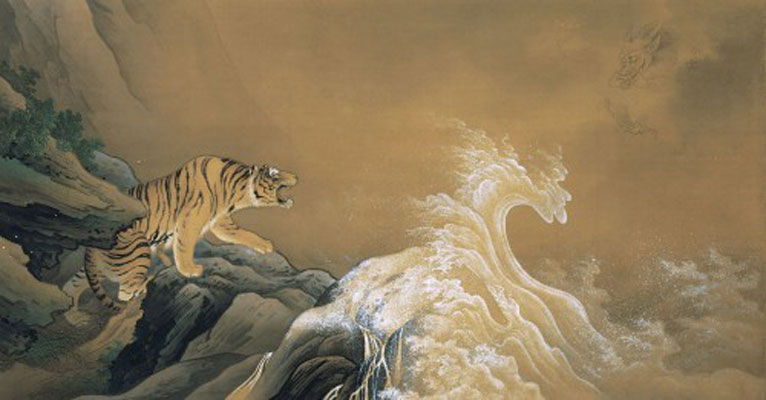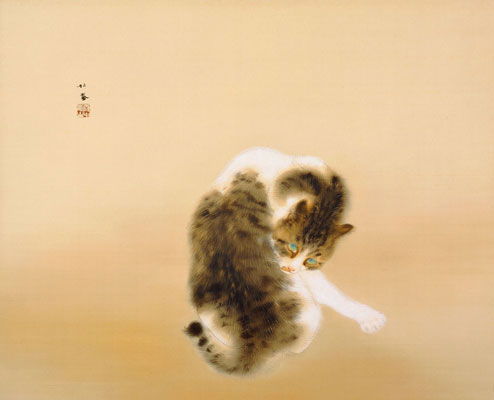Nihonga Movement
The Nihonga movement started in 1882 as a direct result of the forced opening of Japan in 1853 during the Meiji Period. While in Europe this new trade inspired Japonisme, art made by Europeans inspired by Japanese culture, this art exchange also inspired Japanese artists to create art inspired by Western culture and they called this style Yōga. While all of that was happening, there were Japanese artists who wanted to preserve the classical style of Japanese art, and thus the Nijonga movement was born.
While the artists do end up adopting some elements of Western art (such as realism) into their art, they very much remain true to tradition. They also opened up the subjects of their paintings rather than stick strictly to traditional art subjects. The Nihonga movement is still an active art movement within Japan today.
The Art

Dragon Against Tiger (1899) by Hashimoto Gahō in Japan. Image courtesy of The Art Story.
This piece is cited as what convinced artists that adopting elements of Western art can help enhance the traditional elements. Kanô traditionally depicts two creatures and leadership symbolism, and Gahō combined this with realism from Western art to create a Nihonga piece. He also painted this on silk, keeping with traditional methods of painting.
What I like about this piece is how striking the waves are, they are what my eye is drawn to first, followed by the tiger. One thing that could be stronger is the dragon, who is almost lost in the upper right corner of the painting, I had actually missed the dragon completely the first few times I looked at the painting. For a powerful creature, he doesn't have a powerful presence in the piece.

Tabby Cat (1924) by Takeuchi Seihō in Japan. Image courtesy of The Art Story.
This is another painting on silk, this one combines realism with a Ukiyo-e style of negative space and theme. Seihō featured landscapes and animals in his works, and he was leading the Nihonga style in Kyoto.
This is one of my favorites because of how simple it is, but also how realistic the cat is. The vibrant green eyes hold your gaze and give it a sense of seriousness, but the cat is just grooming itself. I also like the contrast of the realism and the negative space background, so your focus is solely on the tabby.

Salmon Slices and Sardines (1924) by Tsuchida Bakusen in Japan. Image courtesy of The Art Story.
Tsuchida Bakusen started off as a Buddhist monk before he would leave monkhood in favor of painting. He studied under Seihō, from the previous art piece in this blog, and used his Buddhist background as inspiration for many of his works. He also was interested in post-impressionists and used other European art as inspiration and wanted to push Nihinga into a more modern direction.
What I like from this work is the number of curves present, and it is balanced by the few pieces of sardines that are in straight lines. The vibrancy of the salmon is accentuated by the muted colors of the surrounding objects. You can see the influence of other art styles as it is not as muted as traditional Japanese art and the fish have a sense of realism.

Football (2006) by Hisashi Tenmyouya in Japan. Image courtesy of PicassoMio.
To emphasize that Nihonga is still active I chose a more recent art piece. This piece by Hisashi Tenmyouya incorporates traditional art methods, he used the Ukiyo-e style and did a block painting. This was used as the poster for the 2006 World Cup in Barcelona. Hisashi calls it Neo-Nihonga as he brings traditional imagery to modern and present-day subjects.
I like the playfulness of the piece, showing the players as warriors. The colors used are also more vibrant compared to more traditional art, showcasing the modernism of the piece. I'm not much of a soccer fan, but this would be the one sports poster I would be proud to hang on my wall.
Final Thoughts
What I really like about this style is how the artists are continually evolving and bringing in new elements, but still staying true to traditional Japanese art. Nihonga was created to try and combat western art from overtaking the art in Japan, and they ended up creating a lasting art style that brings together the best parts of tradition and other styles.
Work Cited
“Football (2006 FIFA World Cup Germany) Original Art by Hisashi Tenmyouya.” PicassoMio, www.picassomio.com/hisashi-tenmyouya/24884.html.
“Nihonga - Concepts & Styles.” The Art Story, www.theartstory.org/movement/nihonga/history-and-concepts/.
“Nihonga - Important Paintings.” The Art Story, www.theartstory.org/movement/nihonga/artworks/.
“Yamatane Museum of Art.” What Is Nihonga? - Yamatane Museum of Art, www.yamatane-museum.jp/english/nihonga/.
I did my non-Western blog on ukiyo-e but I knew nothing about the Nihonga movement. The influence of European techniques definitely comes across in the painting, and I love how it melds with the Japanese sense of negative space and elegance. Dragon Against Tiger is so gorgeously balanced. The subtlety of the dragon is interesting, I wonder if Goho minimized its presence to suggest the dragon is more like an unseen force of nature than a physical creature, inhabiting the wind and waves.
ReplyDeleteI had to find more of this genre and its a trove of beautiful images. I love, love, love the muted otherworldly colors and odd shapes set into hazy negative spaces found in Nihonga landscapes and nature scenes. I want to live in the zen moods found in the paintings in this link.
https://japanobjects.com/features/nihonga
Jada,
ReplyDeleteThank you for your blog post this week. I too like the dreaminess of the ukiyo-e colors and style. ukiyo-e literally means "pictures of the floating world" and was cherished as a form of mass entertainment. I am making a connection with the woodblock print of "football" being a convenient way of reproducing the art. I imagine the World Cup in Barcelona was very popular and many prints were sold. My favorite piece out of your blog has to be "Tabby Cat". I love how the focus on the cats green eyes and the detail in the brush strokes in the cats fur. Bravo!